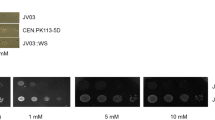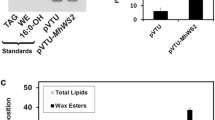Abstract
The bifunctional wax ester synthase/acyl-coenzyme A:diacylglycerol acyltransferase (WS/DGAT or wax ester synthase) catalyzes the terminal reaction in the bacterial wax ester biosynthetic pathway, utilizing a range of alcohols and fatty acyl-CoAs to synthesize the corresponding wax ester. The wild-type wax ester synthase Maqu_0168 from Marinobacter aquaeolei VT8 exhibits a preference for longer fatty alcohols, while applications with smaller alcohols would yield products with desired biotechnological properties. Small and medium chain length alcohol substrates are much poorer substrates for the native enzyme, which may hinder broad application of the wax ester synthase in many proposed biosynthetic schemes. Developing approaches to improve enzyme activity toward specific smaller alcohol substrates first requires a clear understanding of which amino acids of the primary sequences of these enzymes contribute to substrate specificity in the native enzyme. In this report, we surveyed a range of potential residues and identified the leucine at position 356 and methionine at position 405 in Maqu_0168 as residues that affected selectivity toward small, branched, and aromatic alcohols when substituted with different amino acids. This analysis provides evidence of residues that line the binding site for wax ester synthase, which will aid rational approaches to improve this enzyme with specific substrates.




Similar content being viewed by others
References
Atsumi S, Hanai T, Liao JC (2008) Non-fermentative pathways for synthesis of branched-chain higher alcohols as biofuels. Nature 451:86–89
Barney BM (2014) The sweet smell of biosynthesis. Nat Chem Biol 10:246–247
Barney BM, Igarashi RY, Dos Santos PC, Dean DR, Seefeldt LC (2004) Substrate interaction at an iron-sulfur face of the FeMo-cofactor during nitrogenase catalysis. J Biol Chem 279:53621–53624
Barney BM, Laryukhin M, Igarashi RY, Lee HI, Dos Santos PC, Yang TC, Hoffman BM, Dean DR, Seefeldt LC (2005) Trapping a hydrazine reduction intermediate on the nitrogenase active site. Biochemistry 44:8030–8037
Barney BM, Mann RL, Ohlert JM (2013) Identification of a residue affecting fatty alcohol selectivity in wax ester synthase. Appl Environ Microbiol 79:396–399
Barney BM, Wahlen BD, Garner E, Wei J, Seefeldt LC (2012) Differences in substrate specificity of five bacterial wax ester synthases. Appl Environ Microbiol 78:5734–5745
Barney BM, Yurth MG, Dos Santos PC, Dean DR, Seefeldt LC (2009) A substrate channel in the nitrogenase MoFe protein. J Biol Inorg Chem 14:1015–1022
Buglino J, Onwueme KC, Ferreras JA, Quadri LEN, Lima CD (2004) Crystal structure of PapA5, a phthiocerol dimycocerosyl transferase from Mycobacterium tuberculosis. J Biol Chem 279:30634–30642
Corpet F (1988) Multiple sequence alignment with hierarchical-clustering. Nucleic Acids Res 16:10881–10890
Gasteiger E, Hoogland C, Gattiker A, Duvaud S, Wilkins MR, Appel RD, Bairoch A (2005) Protein identification and analysis tools on the ExPASy Server. In: Walker JM (ed) The Proteomics Protocols Handbook. Humana Press, Totowa, NJ, pp 571–607
Hofvander P, Doan TTP, Hamberg M (2011) A prokaryotic acyl-CoA reductase performing reduction of fatty acyl-CoA to fatty alcohol. FEBS Lett 585:3538–3543
Hsiao YS, Jogl G, Tong L (2006) Crystal structures of murine carnitine acetyltransferase in ternary complexes with its substrates. J Biol Chem 281:28480–28487
Jetter R, Kunst L (2008) Plant surface lipid biosynthetic pathways and their utility for metabolic engineering of waxes and hydrocarbon biofuels. Plant J 54:670–683
Jogl G, Tong L (2003) Crystal structure of carnitine acetyltransferase and implications for the catalytic mechanism and fatty acid transport. Cell 112:113–122
Kalscheuer R, Stölting T, Steinbüchel A (2006) Microdiesel: Escherichia coli engineered for fuel production. Microbiology 152:2529–2536
Keating TA, Marshall CG, Walsh CT, Keating AE (2002) The structure of VibH represents nonribosomal peptide synthetase condensation, cyclization and epimerization domains. Nat Struct Biol 9:522–526
Lenneman EM, Ohlert JM, Palani NP, Barney BM (2013) Fatty alcohols for wax esters in Marinobacter aquaeolei VT8: two optional routes in the wax biosynthesis pathway. Appl Environ Microbiol 79:7055–7062
Leslie AGW (1990) Refined crystal-structure of type-III chloramphenicol acetyltransferase at 1.75 Å resolution. J Mol Biol 213:167–186
Mattevi A, Obmolova G, Kalk KH, Teplyakov A, Hol WGJ (1993) Crystallographic analysis of substrate binding and catalysis in dihydrolipoyl transacetylase (E2p). Biochemistry 32:3887–3901
Onwueme KC, Ferreras JA, Buglino J, Lima CD, Quadri LEN (2004) Mycobacterial polyketide-associated proteins are acyltransferases: proof of principle with Mycobacterium tuberculosis PapA5. Proc Natl Acad Sci U S A 101:4608–4613
Reiser S, Somerville C (1997) Isolation of mutants of Acinetobacter calcoaceticus deficient in wax ester synthesis and complementation of one mutation with a gene encoding a fatty acyl coenzyme A reductase. J Bacteriol 179:2969–2975
Rodriguez GM, Tashiro Y, Atsumi S (2014) Expanding ester biosynthesis in Escherichia coli. Nat Chem Biol 10:259–265
Rufer AC, Lomize A, Benz J, Chomienne O, Thoma R, Hennig M (2007) Carnitine palmitoyltransferase 2: analysis of membrane association and complex structure with a substrate analog. FEBS Lett 581:3247–3252
Steen EJ, Kang Y, Bokinsky G, Hu Z, Schirmer A, McClure A, Del Cardayre SB, Keasling JD (2010) Microbial production of fatty-acid-derived fuels and chemicals from plant biomass. Nature 463:559–562
Stöveken T, Kalscheuer R, Malkus U, Reichelt R, Steinbüchel A (2005) The wax ester synthase/acyl coenzyme A:diacylglycerol acyltransferase from Acinetobacter sp. strain ADP1: characterization of a novel type of acyltransferase. J Bacteriol 187:1369–1376
Stöveken T, Kalscheuer R, Steinbüchel A (2009) Both histidine residues of the conserved HHXXXDG motif are essential for wax ester synthase/acyl-CoA:diacylglycerol acyltransferase catalysis. Eur J Lipid Sci Tech 111:112–119
Stöveken T, Steinbüchel A (2008) Bacterial acyltransferases as an alternative for lipase-catalyzed acylation for the production of oleochemicals and fuels. Angew Chem Int Ed Engl 47:3688–3694
Villa JA, Cabezas M, de la Cruz F, Moncalián G (2014) Use of limited proteolysis and mutagenesis to identify folding domains and sequence motifs critical for wax ester synthase/acyl coenzyme A: diacylglycerol acyltransferase activity. Appl Environ Microbiol 80:1132–1141
Wahlen BD, Oswald WS, Seefeldt LC, Barney BM (2009) Purification, characterization, and potential bacterial wax production role of an NADPH-dependent fatty aldehyde reductase from Marinobacter aquaeolei VT8. Appl Environ Microbiol 75:2758–2764
Wältermann M, Hinz A, Robenek H, Troyer D, Reichelt R, Malkus U, Galla HJ, Kalscheuer R, Stöveken T, von Landenberg P, Steinbüchel A (2005) Mechanism of lipid-body formation in prokaryotes: how bacteria fatten up. Mol Microbiol 55:750–763
Wältermann M, Stöveken T, Steinbüchel A (2007) Key enzymes for biosynthesis of neutral lipid storage compounds in prokaryotes: properties, function and occurrence of wax ester synthases/acyl-CoA: diacylglycerol acyltransferases. Biochimie 89:230–242
Willis RM, Wahlen BD, Seefeldt LC, Barney BM (2011) Characterization of a fatty acyl-CoA reductase from Marinobacter aquaeolei VT8: a bacterial enzyme catalyzing the reduction of fatty acyl-CoA to fatty alcohol. Biochemistry 50:10550–10558
Youngquist JT, Schumacher MH, Rose JP, Raines TC, Politz MC, Copeland MF, Pfleger BF (2013) Production of medium chain length fatty alcohols from glucose in Escherichia coli. Metab Eng 20:177–186
Acknowledgments
This work was supported by grants from the National Science Foundation to B.M.B. (Award Numbers 0968781 and CBET-1437758). Further support was provided through generous start-up funds through the University of Minnesota. We thank Eric Lenneman who assisted in the analysis of M. aquaeolei VT8 wax esters.
Conflict of interest
The authors declare no conflict of interest.
Author information
Authors and Affiliations
Corresponding author
Electronic supplementary material
Below is the link to the electronic supplementary material.
ESM 1
(PDF 121 kb)
Rights and permissions
About this article
Cite this article
Barney, B.M., Ohlert, J.M., Timler, J.G. et al. Altering small and medium alcohol selectivity in the wax ester synthase. Appl Microbiol Biotechnol 99, 9675–9684 (2015). https://doi.org/10.1007/s00253-015-6783-y
Received:
Revised:
Accepted:
Published:
Issue Date:
DOI: https://doi.org/10.1007/s00253-015-6783-y




